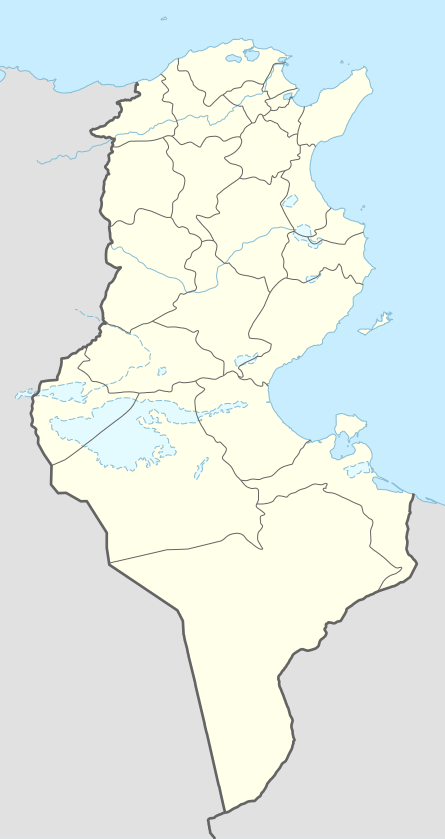Korba, Tunisia
| Korba قربة | |
|---|---|
|
| |
 Korba Location in Tunisia | |
| Coordinates: 36°34′N 10°52′E / 36.567°N 10.867°ECoordinates: 36°34′N 10°52′E / 36.567°N 10.867°E | |
| Country |
|
| Governorate | Nabeul Governorate |
| Population (2014) | |
| • Total | 68,966 |
| Time zone | CET (UTC1) |
Korba (Tunisian Arabic: قربة ![]() qorbā), ancient Curubis, is a town in Tunisia on the eastern shore of the Cap Bon. It was the place of exile of the Carthaginian bishop Cyprian in the year leading up to his martyrdom. Modern Korba is in the Nabeul Governorate and had a population of 34,807 in 2004.[1]
qorbā), ancient Curubis, is a town in Tunisia on the eastern shore of the Cap Bon. It was the place of exile of the Carthaginian bishop Cyprian in the year leading up to his martyrdom. Modern Korba is in the Nabeul Governorate and had a population of 34,807 in 2004.[1]
History
Ancient geographers and itineraries mention the town Curubis on the African coast between Clupea (modern Kelibia) and Neapolis (modern Nabeul).[2]
The earliest historical record is an inscription from the time of the Roman civil war, which records that the Pompeian generals P. Attius Varus and Gaius Considius Longus fortified the town in 46 BC.[3] In the years after the civil war the town was made a Roman colony, colonia Iulia Curubis (Pliny the Elder refers to it as libera, "free"), perhaps as part of Julius Caesar's attempt to rid his army of older soldiers and at the same time hold Africa against Pompeian forces.[4] In the year AD 257, the Carthaginian bishop Cyprian was exiled there; his biographer Pontius, who accompanied him into exile, praises the place (12): "provisum esse divinitus … apricum et conpetentem locum, hospitium pro voluntate secretum et quidquid apponi eis ante promissum est, qui regnum et iustitiam dei quaerunt." ("by God's favour a sunny and appropriate place was provided, a refuge secluded as he wished, and whatever was previously promised to be set before those who seek the kingdom and justice of God").
By the year 411, Curubis, like many African towns, had its own bishop. In that year, the Donatist Victor took part in the joint Conference of Carthage between Catholic and Donatist bishops. Felix was one of the Catholic bishops that the Arian Vandal king Huneric summoned to Carthage in 484 and then exiled to Corsica. Peregrinus was at the Council of Carthage of 525. Bennatus put his signature to the acts of another council held in 646 to condemn Monthelism.[5][6][7] No longer a residential bishopric, Curubis is today listed by the Catholic Church as a titular see.[8]
The town had its own theatre. An inscription of the late 2nd century honours the citizen who had created it.[9] Remains of an aqueduct survived to modern times; and the contribution to a mosaic in Ostia by shipowners of Curubis suggest that the town also possessed a port, which has not survived.[10]
A recent account of the life in Korba may be found in Mounira Khemir's narrative "Un coin du carré bleu"[11]
Literature
- Broughton, T.R.S. (1929) The Romanization of Africa Proconsularis (Baltimore and Oxford: The Johns Hopkins Press and OUP)
- Dessau, H. (1901) "Curubis" R.E. IV 1893
- Mommsen, T., (1895) "Inschriften von Curubis und Lilybaeon", Hermes 30, 456-62 (online at Gallica)
- Trousset, P. (1994) "Curubis (Korba)" Encyclopédie Berbère, 2157 (Aix-en-Provence: Édisud) ISBN 2-85744-201-7
Footnotes
- ↑ Recensement de 2004 (Institut national de la statistique) Census
- ↑ Plin. nat. 5, 24 libera (sc.oppida) Curubis, Neapolis "free cities, Curubis, Neapolis"; Ptol. 4, 3, 2; Itin. Anton. Aug. p. 56, 7. al. See Dessau (1901); TLL Onom. II 771, 11 sqq.
- ↑ CIL VIII 24099; Mommsen (1895), 456-60 with discussion of the inscription; Dessau (1901).
- ↑ Broughton (1929), 54-5; CIL VIII 980 and 12452. The town was apparently already a colony by the year 45 BC, when an inscription, CIL VIII 12451, shows a duovir again repairing the walls, or possibly, as Mommsen (1893), 460, suggests, completing the construction begun by the Pompeian generals. For discussion of the puzzles of this inscription, see CIL I2 p. 951, with further literature.
- ↑ J. Ferron, v. Curubis in Dictionnaire d'Histoire et de Géographie ecclésiastiques, vol. XIII, Paris 1956, coll. 1115-1116
- ↑ Stefano Antonio Morcelli, Africa christiana, Volume I, Brescia 1816, pp. 149–150
- ↑ Pius Bonifacius Gams, Series episcoporum Ecclesiae Catholicae, Leipzig 1931, p. 465
- ↑ Annuario Pontificio 2013 (Libreria Editrice Vaticana 2013 ISBN 978-88-209-9070-1), p. 877
- ↑ Inscriptiones Latinae Selectae (ed. Dessau) n. 9407.
- ↑ Trousset (1994); CIL XIV 4549, 34 naviculari Curbitani (late second century).
- ↑ 10 Mounira Khemir, "Un coin du carré bleu" in Enfances tunisiennes, Ed.Elyzad,Tunis,2010
External links
| Wikimedia Commons has media related to Korba. |